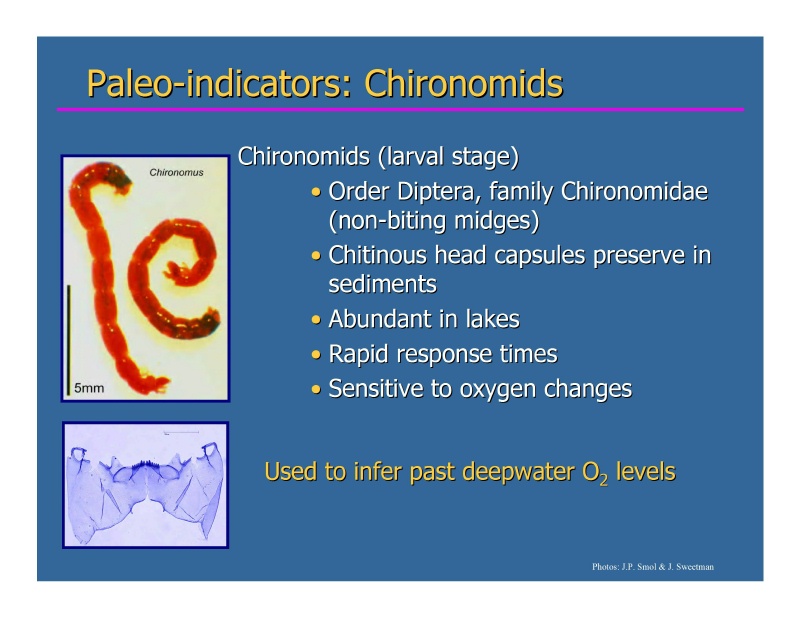
Disclaimer & Copyright Notices; Optimized for the MS Internet Explorer

January 01, 2016 ![]() Acknowledgements: NSFA and the T.E.A.M., Ontario
Acknowledgements: NSFA and the T.E.A.M., Ontario
Chironomidae (Diptera) have been long considered useful indicators of paleoecological conditions such as hypolimnetic dissolved oxygen. Using a combination of the `top-bottom' paleolimnological approach and detailed sediment core analysis of 4 lakes, this study addresses the questions: Have hypolimnetic oxygen levels decreased in these lakes; If so, when and by how much? Twelve lakes from Nova Scotia were selcted for study based on usage patterns, environmental concern, historical data availability or economic importance. Top-bottom analysis, where bottom sediments represented ca. 1850 AD or older, displayed high taxonomic similarity,. Heterotrissocaldius and Micropsectra, two indicators of oxygen-rich hypolimnetic water, were present in both top and bottom intervals of most lakes. These taxa were also well represented in the four detailed lakes. Chironomus, an indicator of anoxia, was not abundant in any interval of this lake set.
Based on the continued representation of Heterotrissocaldius and Micropsectra in both the pre-industrial and present-day assemblages, the deepwater oxygen conditions of these lakes have apparently changed little. Discrepancies between some measured and my inferred oxygen levels are likely attributed to intra-season or inter-seasonal variability. However, continued monitoring of these lakes is highly recommended as precariously low concentrations of hypolimnetic oxygen have been recorded."
The continued if not increased occurrence of taxa representing a well-oxygenated hypolimnium in post-industrial sediments suggests that hypolimnetic anoxia has not increased in these lakes. However, water quality sampling conducted by Brylinsky (2002) and NSFA clearly show low-levels of hypolimnetic oxygen in most lakes.
This discrepancy may be explained by Quinlan and Smol's (2001) observation of taxa representative of a well-oxygenated hypolimnium in lakes with entire end of summer hypolimnetic anoxia. They postulated that if summer warming is gradual, oxic taxa may start their lifecycle, and deposit head capsules during instar development prior to death as a result of unfavourable anoxic hypolimnetic conditions. Taxa representing well-oxygenated hypolimnetic waters could therefore be present in the subfossil record, despite lack of available habitat throughout their entire lifecycle.
Other important considerations for discerning the discrepancy between measured and inferred water quality are intra-season and inter-seasonal variability. Many abiotic (temperature, oxygen levels) and biotic factors (predation and competition) are known to influence this variability. Various studies have demonstrated seasonal-specific adult emergence of temperate tribes between spring and late summer, the timing of which is directly related to larval development. With an average one year lifecycle in temperate chironomids, larvae may be exposed to periods of extreme temperature and oxygen stress throughout a year. Due to late-summer emergence of adult Chironomidae and Tanypodinae, their larvae may be less-susceptible to mid- to late- summer anoxia than spring emergent Orthocladiinae. Chironomidae and Tanypodinae taxa do comprise the majority of individuals in my samples; however the sample resolution of this study was not fine enough to tease out any impacts of inter-seasonal effects on the observed assemblages.
It should be noted that I caution the over-interpretation of these data. Although the paleolimnological results do not indicate a regional trend of reduced hypolimnetic oxygen over the last ~150 years, it is possible that my sampling resolution is not of fine enough scale to detect short-term seasonal reductions in suitable hypolimnetic quality. This may explain the differences between measured DO and my chironomid inferred DO. Regardless, this chironomid data set does shed light on brook trout lake water quality, in that hypolimnetic oxygen levels do not seem to be decreasing on a long-term, regional scale."
We salute the Chebucto Community Net (CCN) of Halifax, Nova Scotia, Canada for hosting our web site, and we applaud its volunteers for their devotion in making `CCN' the best community net in the world